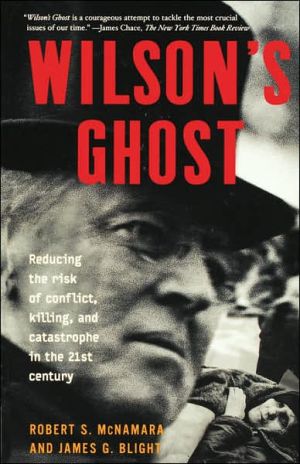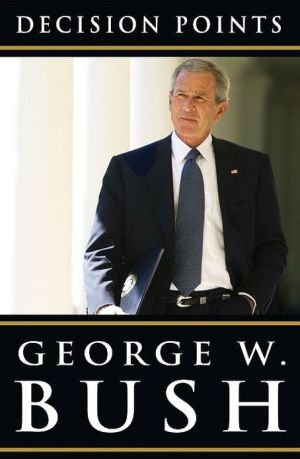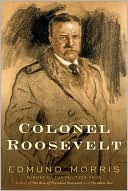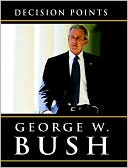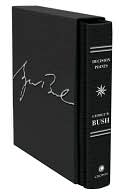Wilson's Ghost: Reducing the Risk of Conflict, Killing, and Catastrophe in the 21st Century
With Wilson's Ghost, Robert S. McNamara and James G. Blight deliver an impassioned plea and a decisive and multi-faceted program for making the 21st century a more peaceful century than the last. The terrorist attacks of September 11, 2001, and the war that has followed, have made their argument even more imperative. In a provocative synthesis of the pragmatic, historical, and philosophical arguments for avoiding war and achieving a sustainable peace, McNamara and Blight put forth a plan for...
Search in google:
REVISED AND UPDATED Former Secretary of Defense Robert S. McNamara, the bestselling author of In Retrospect, draws on a lifetime of experience to offer a manifesto for ending the scourge of war in the 21st century Library Journal Former Secretary of Defense McNamara is 85 and still atoning for his role in the Vietnam conflict (see In Retrospect: The Tragedy and Lessons of Vietnam, LJ 4/15/95). His new book, written with international relations expert Blight, takes the ideas and idealism of Woodrow Wilson and sets forth a moral and multilateral formula for achieving peace in the world. The authors advocate the importance of "democratic decision-making" in U.S. foreign policy and increased empathy toward Russia and China. They also warn that the plague of communal violence within nations poses a dilemma for the United States and international organizations, as intervention might not lead to a satisfactory solution of the conflict. McNamara and Blight are especially eloquent in their pleas to end the threat of nuclear catastrophe, and McNamara inserts his personal reflections on the Cuban missile crisis (as well as on the lost opportunities for an early resolution in Vietnam). The authors critique major foreign policy theories and develop a convincing "Wilsonian" framework for U.S. policy. This stimulating and challenging work will do much to redeem McNamara's legacy; recommended for academic and large public libraries. Thomas A. Karel, Franklin & Marshall Coll. Lib., Lancaster, PA Copyright 2001 Cahners Business Information.
\ \ Chapter One\ \ \ A Radical Agenda\ \ \ The U.S. Role in Global Security in the 21st Century\ \ \ The end of the Cold War ushered in a brief period of optimism about prospects for world peace in the 21st century. Speaking at the United Nations in October 1990, President George Bush welcomed "a partnership whose goals are to increase democracy, increase prosperity, increase the peace, and reduce arms." Three years later President Bill Clinton told the United Nations that "in a new era of peril and opportunity, our overriding purpose must be to expand and strengthen the world's community of market-based democracies." Yet by the beginning of the 21st century, even as America's political, economic, and military power remained unchallenged, such grand pronouncements are seldom made without attached qualifications, ambivalence, and uncertainties. Why? Because throughout the post-Cold War period, brutal war and communal killing on an alarming scale have increased, and the danger of nuclear catastrophe remains ever present. The ghost of Woodrow Wilson, the fear of failing to prevent a post-war catastrophe again, has become pervasive. In the following chapters we emphasize that our first responsibility is to reverse these alarming and dangerous global trends. We lay the foundation for a new foreign and defense policy for America and the world based on a moral imperative to reduce deaths from war, and a U.S. commitment to lead the world toward that objective but never to apply its political, economic, or military force unilaterally.\ \ \ The Great Illusion of the 20th Century\ \ \ As we look back from the 21st century on the events of the 20th, we cannot help being struck by the enormity of the human carnage, beginning with the First World War. It is in fact difficult to avoid the conclusion that something in the stars must have cursed the 20th century, must have determined that it would be almost uniformly bloody, from beginning to end. And yet, it is useful to recall that at its outset, the 20th century looked to many thoughtful and informed people to hold unlimited promise of peace and prosperity. Witnessing the explosion of technology-driven economic interdependence, some even believed that major war had become obsolete, just as the horse and buggy was becoming obsolete. In retrospect, this belief may have led to a degree of complacency that itself contributed to the onset of the First World War. Dare we, in a subsequent era of burgeoning interdependence, claim that it can't happen again?\ By 1910, Europe was enjoying unprecedented growth and prosperity, a circumstance made possible by an equally unprecedented degree of cooperation and integration among the economies of the major nations of Europe, and of the United States. At about this time, many political leaders, intellectuals, industrialists, and ordinary citizens of these countries made what the Oxford historian Niall Ferguson recently called "the greatest error of modern history." They reasoned—some consciously, some less so—as follows: First, the new interdependence and cooperation among the Great Powers was necessary for prosperity; second, anything that destroyed these conditions for prosperity would also destroy prosperity itself; third, an outbreak of war involving the Great Powers would certainly disrupt, possibly even destroy, prosperity; fourth, this connection between war and economic disaster was understood by all concerned; therefore, fifth, a major war was unthinkable. The road to the hell that was the First World War was "paved" with this logic: Since war had become economically counterproductive, it would be deterred by awareness of this fact or, in the quite unlikely event of an outbreak of war, hostilities would quickly be terminated, for the same reason.\ This line of thinking was formalized in a 1910 best-seller by the British journalist Norman Angell, The Great Illusion: A Study of the Relation of Military Power to National Advantage. Angell set out to prove that war had become irrational—not worth the cost—and thus a thing of the past. Angell asked: "What is the real guarantee of the good behavior of one state to another?" His answer: "It is the elaborate interdependence which, not only in the economic sense, but in every sense, makes an unwarrantable aggression of one state upon another react upon the interests of the aggressor." Because war no longer made sense, Angell said, "the day for progress by force has passed; it will be progress by ideas or not at all." Speaking two years after the publication of The Great Illusion, Angell drew this conclusion: "Morality after all is not founded on self-sacrifice, but upon enlightened self-interest, a clearer and more complete understanding of all the ties that bind us the one to the other. And such understanding is bound to improve." The Americans were far from immune from this quaint but deadly complacency. David Starr Jordan, the president of Stanford University, said in a 1910 speech at Tuffs University that "future war is impossible because the nations cannot afford it."\ Not everyone was convinced. In his 1910 essay "The Moral Equivalent of War," the American philosopher William James admitted that "modern war is so expensive that we feel trade to be a better avenue to plunder," but, he added, "modern man inherits all the innate pugnacity and all the love of glory of his ancestors. Showing war's irrationality and horror is of no effect on him. The horrors make the fascination." James's remark is an almost clairvoyant description of events all over the British isles in August 1914, when young men by the hundreds of thousands, laughing and carrying on as if on their way to a sporting event or a picnic, deluged conscription centers in an effort to be among the first to fight.\ The "great illusion" Norman Angell set out to debunk in 1910 was the outmoded belief, as he saw it, that any economic or other advantage derives from military conquest. Having proved this to his satisfaction, and to the satisfaction of his many readers, he concluded that war had become an absurdity and therefore wildly improbable. This was the great illusion of the 20th century. It would be refuted four years after the appearance of Angell's book by the First World War, and again by the Second World War and the Cold War, which followed in its wake.\ \ \ The Tragic Reality of the 20th Century\ \ \ In reality, the 20th century became the bloodiest by far in all of human history. How bloody was it? The available statistics, while helpful in comparative terms, are often wildly erroneous in literal terms. Before listing some of the estimates, therefore, it is necessary to convey the warning given by Dan Smith, director of the International Peace Research Institute in Oslo, Norway (PRIO), whose atlas, The State of War and Peace, is a leading reference on war deaths and related issues:\ \ \ Data on war deaths are supremely unreliable. Among the reasons for this are the propaganda needs of the contending sides. In most wars, there is no agency whose task it is to count the civilian dead who constitute the vast majority of war fatalities.... Estimates are not factual but human and political. The issue is not about statistics. Putting a figure to the number of deaths [is] simply a shorthand from which the horror of what was happening could be easily understood.\ \ \ Almost anyone who is motivated to count war dead, therefore, and who is in a position to do so, is also likely to be a partisan of one side or another in an ongoing war. The issuance of so-called data on war dead is often little more than carrying on the war by statistical means. That said, it is worthwhile considering some estimates from people who make it their business to sift through the numbers, taking the biases into account as best they can.\ What is a war? The PRIO group defines it as: "an open armed conflict about power or territory, involving centrally organized fighters and fighting with continuity between clashes." On the number of such wars in the 20th century (through 1995, the last date for which the data are regarded as reasonably comprehensive), one widely cited estimate identifies, between 1900 and 1995, 83 interstate wars and 135 intrastate wars, for a total of 218 wars. This is compared with 102 interstate wars, 69 intrastate wars, and a total of 171 wars between 1816 and 1899. And war became much more lethal in the 20th century than in previous eras; in fact, it has been estimated that in the 20th century there were "six times as many deaths per war as in the 19th." In total, it appears that something on the order of 110 million people died due to wars between 1900 and 1995. One often-cited source, Ruth Leger Sivard's World Military and Social Expenditures, fixes the number of war deaths at (a curiously precise) 109,746,000.\ Indicative of the changing nature of war are the rates at which civilians have been victimized. One source breaks down an estimated 105 million killed in 20th-century wars into 43 million military dead and 62 million civilian dead. Another estimates that whereas at the end of the 19th century, approximately 10 percent of war deaths were civilians, 50 percent were civilians in the Second World War, and 75 percent were civilians in the wars fought in the 1990s. From all these estimates, it is clear that in the 20th century, war was a common occurrence, it was increasingly lethal, and its toll fell primarily on civilians—noncombatants, the elderly, women, and children.\ The 20th century was not just history's bloodiest century but also the century in which noncombatant immunity—long held in the West to be a requirement of a "just" war—virtually ceased to operate. German journalist and scholar Josef Joffe recently gave this epitaph to the 20th century:\ \ \ How will we remember the 20th century? First and foremost, it was the century of the Three T's: total war, totalitarianism and terror.... In the 18th and 19th centuries, enemies were defeated; in the 20th, they were exterminated in [places like] Auschwitz or in the killing fields of Cambodia.\ \ \ This applies equally to the roughly 140,000 people who died instantly at Hiroshima on August 6, 1945, and to the victims of the systematic terror inflicted over decades by Stalin and Mao on their own people. No one knows how many died in the Stalinist purges and forced removals of the 1920s and 1930s, or how many died due to famines associated with Mao's Great Leap Forward initiatives and from the chaos of the Cultural Revolution. (The number usually cited is 20 million in each country.) Suffice it to say that millions died due to Stalinist and Maoist cruelty and mistakes.\ It is obvious that whatever one fixes as the number killed in war and domestic conflict in the 20th century, the number must be understood as indicating only the approximate level of magnitude of the tragedy. No matter how the total is broken down, there can be nothing approaching numerical precision regarding any of the constituent numbers.\ But if approximately 110 million died in war from 1900 through 1995; and if 20 million each died due to the brutal policies of Stalin and Mao; and if approximately 10 million died in war, or for reasons related to war, between 1995 and 2000 (a figure commonly used), we arrive at the figure of 160 million killed in conflict—including interstate and intrastate conflict. We believe this figure—l60 million war and war-related deaths—is a useful approximation that illustrates the level of violence in the century just ended.\ As we have indicated, most of these 160 million or so would have been civilians. How many? If we add the 60 million civilians we calculate were killed in war to the estimated 40 million who died due to Stalin's and Mao's ideologically driven internal violence, on the order of 100 million of the 160 million killed due to violence and war in the 20th century were innocent civilians—an appalling statistic. Whatever the actual numbers may have been, there can be no dissent from the assessment of the 1997 report of the Carnegie Commission on Preventing Deadly Conflict: those numbers we can derive, however imperfectly, tell a tale of "mass violence on a scale that dwarfs all previous centuries."\ The trend toward civilian victimization due to war is continuing. An illustration of this is reported in a June 2000 epidemiological study of the conflict in the Democratic Republic of the Congo (formerly Zaire). The study estimated that "since January 1, 1999, there have been at least 1.6 million deaths in war-affected areas, over and above the 600,000 deaths that would have occurred in normal times." Approximately 15 percent of the deaths seem directly attributable to the various wars underway. "The rest," according to the report, "resulted from ... preventable or curable diseases that have proliferated amid the social and economic chaos caused by the war, with most in the latter group being women and small children." The wholesale slaughter of innocents that became the grisly hallmark of the 20th century thus continues into the 21st.\ While the numbers permit an appreciation of the scale of the tragedy, they can also be mind-numbing: so many wars, so many millions of dead, so many tragic cases. But numbers of course cover only those aspects of the horror of the 20th century that can be quantified, however roughly and unreliably. Poets, novelists, memoirists, playwrights, painters, photographers, and filmmakers are left to convey as best they can the human tragedy as it has occurred, human being by human being. Alongside the numbers, we need to consider individualized records of the colossal tragedy of 20th-century violence and war. We need to think about the Cambodian women who are blind, but who have no known organic defect, and are assumed to have witnessed horrors so unspeakable that physical blindness resulted as a protective mechanism. We need to meditate on the moment in William Styron's novel Sophie's Choice, when Sophie arrives at a concentration camp and is forced by a Nazi prison guard to decide, then and there, which of her two children shall live and which shall be killed by the Nazis. We need to stare for a while at the recent photographs taken by James Nachtwey of the victims of torture in the wars in West Africa and elsewhere. We must try to identify with other human beings who have been victimized by war and violence—like the hundreds of children whose arms and legs were brutally chopped in half recently in Sierra Leone—in order to make human sense of the numbers, and in order to be moved by the numbers to take preventive action.\ In this way, we can guard against the tendency to treat numbers of this magnitude as if they were only numbers. They are not. Attached to every number is the suffering and premature extinction of an individual human being, a person capable of enjoying life, of suffering, and of facing death quite consciously, often courageously—they were all human beings who were, or who should have been, treated as selves, as ends in themselves. Long before the 20th century, the human race became familiar with the perversion of Immanuel Kant's imperative—of treating people as means, rather than ends. What is a soldier but a person willing to fight and sacrifice himself for a cause—to become a means for achieving victory? But in the 20th century, the debasement of Kant's imperative was taken a step further, as human beings' relation to war and violence became, by and large, neither an end nor a means. Most victims of war became something that simply got in the way—to be destroyed and discarded, like rubbish. Thus in the 20th century, dying in war or because of war became, for the first time, largely meaningless or absurd.\ \ \ What Kind of World for the 21st Century?\ \ \ The post-Cold War world is in many ways as surprising and as violent as that which confronted Norman Angell and his shocked contemporaries with the outbreak of the First World War. Beginning in late 1989, states, nations, and peoples were suddenly freed from the constraining influence of the two "blocs" headed by the United States and the Soviet Union. Thus liberated, their territorial claims, ethnic rivalries, religious differences, historical grievances, and other sources of tension led to widespread violence and killing. Indeed, by the mid-1990s, war and civil violence arising from such roots had become pervasive and unmanageable in many parts of the world.\ In response, the Carnegie Corporation of New York established a high-profile international Commission on Preventing Deadly Conflict, headed by former U.S. Secretary of State Cyrus Vance and Carnegie Corporation president Dr. David Hamburg. The commission's 1997 report is focused squarely on new threats that are likely to be central in the 21st century:\ \ \ Peace will require understanding and respect for differences within and across national boundaries. We humans do not have the luxury any longer of indulging our prejudices and ethnocentrism. They are anachronisms of our ancient past. The worldwide historical record is full of hateful and destructive behavior based on religious, racial, political, ideological, and other distinctions—holy wars of one sort or another. Will such behavior in the next century be expressed with weapons of mass destruction? If we cannot learn to accommodate each other respectfully in the twenty-first century, we could destroy each other at such a rate that humanity will have little to cherish.\ \ \ According to the commission, a crisis has arisen due to the convergence of several factors: the "unlocking" of widespread communal violence at the end of the Cold War; unchecked population growth in many areas prone to such violence; and the widespread availability of lethal weapons and high technology (not excluding the knowledge of how to construct weapons of mass destruction). It is not the sort of crisis with which officials in Washington and Moscow were obsessed during the Cold War—a direct confrontation between nuclear-armed Great Powers. Rather, it is a "crisis in slow motion"—violence that escalates slowly at first, then more rapidly until, by the time it gets the attention of high-level officials, the situation may be sufficiently perverse that nonescalatory options seem out of the question. The escalation of the conflict in Vietnam in the 1960s was an example of this.\ We see evidence of this on all sides: the Iraqi invasion of Kuwait, the civil wars in the former Yugoslavia, the turmoil in northern Iraq, the tension between India and Pakistan, the unstable relations between North and South Korea and between China and Taiwan, and the conflicts across the face of sub-Saharan Africa in Somalia, Sudan, Ethiopia and Eritrea, Rwanda, Burundi, the Democratic Republic of the Congo, Sierra Leone, and Liberia. These all make clear that the world of the future will not be without conflict—conflict among disparate groups within nations and conflict extending across national borders. Racial, religious, and ethnic tensions will remain. Nationalism will be a powerful force across the globe. Political revolutions will erupt as societies advance. Historical disputes over political boundaries will endure. And economic disparities among and within nations will increase as technology and education spread unevenly around the world. The underlying causes of conflict that existed long before the Cold War began remain now that it has ended. They will be compounded by civil strife among the states of the former Soviet Union and by continuing tensions in the Middle East. It is just such tensions that in the past 50 years have contributed to the deaths of tens of millions of people in war.\ When the Carnegie Commission report was issued it was greeted with skepticism in some quarters. The skeptics felt the authors had exaggerated the problem of war and violence in the 21st century. We disagree. Consider the following calculations, which, while speculative, we consider to be conservative:\ \ \ · Estimates given in the previous section list the number of wars fought in the 20th century as 218.\ \ \ · Assume no increase in the number of wars in this century versus the last and no increase in their intensity.\ \ \ · But recognize that the average population of the globe will increase roughly threefold.\ \ \ Under these circumstances fatalities from war would be substantially higher, at least 300 million. Further, let us assume that the rate of civilian casualties remains constant at approximately 75 percent (which is judged to be the approximate post-Cold War rate in the 1990s). In this case, 75 percent of 300 million yields a projected 225 million civilian war deaths.\ We reiterate that these numbers are speculative. The estimation of past war deaths is just that—estimation, based on data of often unknown reliability. To the uncertainty attached to estimates of the pattern and number of war deaths in the 20th century we must, in dealing with projections into the 21st century, add additional uncertainties: the rate of technological advance and dissemination; political leadership or its lack; and a host of other essentially unknowable factors. So neither we, nor the Carnegie Commission, nor anyone else can say with any degree of precision how many people will have died in war by December 31, 2100. But our projections—300 million war deaths, 225 million of them civilians—may well be underestimates!\ We believe strongly, therefore, that the urgency of the Carnegie Commission's call to war prevention in the 21st century is warranted. We simply cannot believe that our increasingly interdependent global village—civilization as we know it—can in this century withstand the killing of anything like 225 million innocent civilians without leading to political, economic, and social instability that would severely penalize most, if not all, nations and all peoples.\ And what if—as seems entirely possible—nuclear weapons were to be used in one or more of these conflicts? In that case, our estimates for war deaths would have to be revised significantly upward. For example, just a few nuclear detonations in a border war between India and Pakistan would likely kill millions—perhaps tens of millions—in densely populated South Asia. The same applies to a nuclear conflict in the Middle East between Israel and one or more Arab adversaries. And it is highly probable that the United States would be drawn inexorably into any conflict of this magnitude. Then what of the Russians and Chinese? What form would their probable involvement take? Alas, this worst-case scenario may not be as unlikely as we all hope it is.\ Estimates from the period 1990-1995 support the view that "conflicts" are occurring at a rate that could have catastrophic results of the magnitude hypothesized in the preceding paragraphs. Using relatively conservative numbers throughout, PRIO recently published its analysis of war deaths in the half decade following the end of the Cold War. They find that the number of wars each year was fairly constant and that, at a minimum, 5.5 million people were killed between 1990 and 1995 as a direct result of war, with an unknown number dying due to chaos, starvation, disease, and other factors associated with war. Other estimates are much higher. As we have said, approximately 8.5 million people are said to have died in the First World War. Those four and a half years of killing led directly to a century of bloodshed and tension among the Great Powers. According to the PRIO estimates, the post-Cold War world contains civilizations, cultures, and nations that are already at, or beyond, the breaking point. These failed or failing states will continue to be a breeding ground of instability, violence, and killing.\ No one has made this point more forcefully than the American journalist Robert D. Kaplan, whose now famous 1994 article on sub-Saharan Africa, "The Coming Anarchy," appeared in the Atlantic Monthly just months before the genocide in Rwanda. Kaplan reports that wherever he went throughout the region, he carried a letter from a friend, a member of the U.S. foreign service in West Africa. The note said:\ \ \ The greatest threat to our value system comes from Africa. Can we continue to believe in universal principles as Africa declines to levels better described by Dante than by development economists? Our domestic attitudes on race and ethnicity suffer as Africa becomes a continent-wide "Wreck of the Medusa."\ \ \ The reference is to an early 19th-century shipwreck whose survivors nearly starved to death, and which is depicted in a horrifying 1819 painting by the French artist Théodore Géricault, The Raft of the Medusa. Kaplan returns repeatedly to this letter throughout his journey, and to the macabre warning given him by a woman in Danane, in the western Ivory Coast: "The thieves are very violent here," she said, "they will cut you up if you are not careful."\ Leaving ravaged West Africa, Kaplan then traveled to other "ends of the earth": Iran, Afghanistan, and Cambodia among them. He was searching, he says, for "a paradigm for understanding the world in the early decades of the 21st century." He found none. He did, however, reach this conclusion: "We are not in control." He notes that the failure of just a few relatively insignificant states in the post-Cold War era has overwhelmed the West's (and the UN's) coping mechanisms. What will happen, he asks himself, when a major regional power implodes and ceases to function? Will it be nuclear-armed Pakistan? Or will it be Iraq, perhaps following another war? Or possibly Russia, collapsing into anarchy? In all such eventualities, he muses, "we would have no answers."\ Of course, West Africa of the 21st century is not the whole world, nor are places like Pakistan or even Russia. Some may be reluctant to follow Kaplan all the way to his apocalyptic conclusion: that "the coming anarchy" will soon leave no people, no country untouched—that Dante's West African inferno may impact on all of us at some point in the 21st century, with chaos and anarchy spreading like a communicable disease, or even faster, like a computer virus, throughout the world. Yet we believe the image is a useful one to keep in mind, an impressionistic yet powerful complement to our calculations above regarding war deaths in the century ahead.\ Such situations exist. Other human beings, people like ourselves, are already burning in Dantean infernos. Whole nation-states are on the brink of collapse. At a minimum, they deserve our sympathy and whatever assistance we can give. But we must also consider the possibility that their fate and ours may be linked to a greater extent than we suppose. How much chaos, turmoil, and killing can occur before the cool islands of tranquility in which we live begin to burn? The Canadian journalist Michael Ignatieff has written that "most of us persist in the belief that while the fires far away are terrible things, we can keep them from our doors, and that while they may consume the roofs of our neighbors, the sparks will never leap to our own." We suggest that the figurative "sparks"—refugees, ethnic killing, disease, chronic political instability, perhaps leading to major war, even nuclear war—will begin to burn down (or at a minimum, severely damage) our own abode long before 300 million people are killed in war in this century. We propose to confront this danger by action based on a moral imperative.\ (Continues...)
Preface to the Paperback EditionA Note from Robert McNamaraA 21st-Century Manifesto: Choose Life over DeathPrologue: Wilson's Tragedy, and Ours31A Radical Agenda: The U.S. Role in Global Security in the 21st Century172Preventing Great Power Conflict: Bringing Russia and China in from the Cold593Reducing Communal Killing: Intervention in "Dangerous, Troubled, Failed, Murderous States"1134Avoiding Nuclear Catastrophe: Moving Steadily and Safely to a Nuclear-Weapons-Free World1695Reducing Human Carnage: An Agenda for the 21st Century217Epilogue: Listening to Wilson's Ghost227Afterword to the Paperback Edition: Wilson's Ghost in the Post-9/11 World231Notes277Acknowledgments303About the Authors307Index309
\ From Barnes & NobleEver since he served as Secretary of Defense under Presidents Kennedy and Johnson, Robert S. McNamara has been rethinking the bloody calculus of war. After he left office, he decided that the Vietnam War that he helped direct was "wrong, terribly wrong" and resolved to study how conflicts arise and how they can be pre-empted by intelligent consensus. Invoking the idealism of Woodrow Wilson, McNamara and coauthor James Blight explain how festering conflicts can be averted by collective security arrangements, the avoidance of great-power conflict, and the abolition of weapons of mass destruction. Instructive and opinionated, Wilson's Ghost is certain to enrich any discussion of international affairs.\ \ \ \ \ Library JournalFormer Secretary of Defense McNamara is 85 and still atoning for his role in the Vietnam conflict (see In Retrospect: The Tragedy and Lessons of Vietnam, LJ 4/15/95). His new book, written with international relations expert Blight, takes the ideas and idealism of Woodrow Wilson and sets forth a moral and multilateral formula for achieving peace in the world. The authors advocate the importance of "democratic decision-making" in U.S. foreign policy and increased empathy toward Russia and China. They also warn that the plague of communal violence within nations poses a dilemma for the United States and international organizations, as intervention might not lead to a satisfactory solution of the conflict. McNamara and Blight are especially eloquent in their pleas to end the threat of nuclear catastrophe, and McNamara inserts his personal reflections on the Cuban missile crisis (as well as on the lost opportunities for an early resolution in Vietnam). The authors critique major foreign policy theories and develop a convincing "Wilsonian" framework for U.S. policy. This stimulating and challenging work will do much to redeem McNamara's legacy; recommended for academic and large public libraries. Thomas A. Karel, Franklin & Marshall Coll. Lib., Lancaster, PA Copyright 2001 Cahners Business Information.\ \ \ BooknewsPresident Kennedy's former Secretary of Defense Robert McNamara and coauthor Blight (international studies, Brown U.) offer suggestions as to how the United States could and should change its foreign policy and defense policy to incorporate the core objectives of post-WWI Wilsonian ideals. They suggest that the United States make the end of war a major goal of foreign policy and argue that while the U.S. will have to provide leadership, it must not apply its economic, political, or military policy unilaterally. In order to successfully maintain a peaceful world, they believe that a complete rapprochement with China and Russia is necessary in order to prevent the real dangers of Great Power conflict. In addition they offer suggestions towards strengthening the U.N. in a move towards true multilateralism in the reduction of communal violence and the threat from nuclear weapons. Annotation c. Book News, Inc., Portland, OR (booknews.com)\ \
